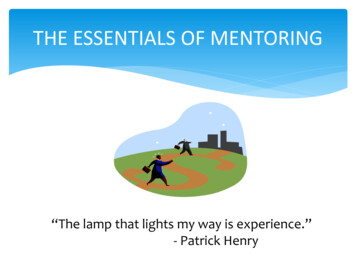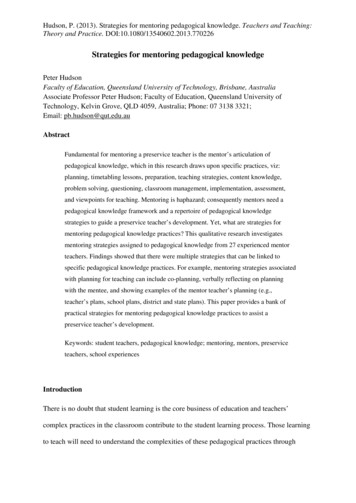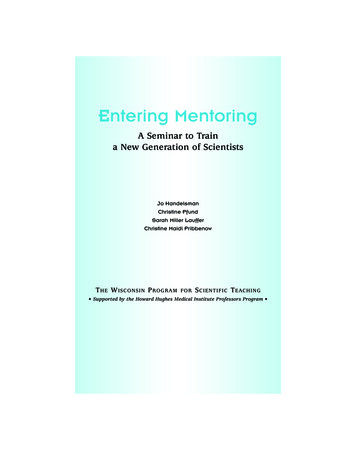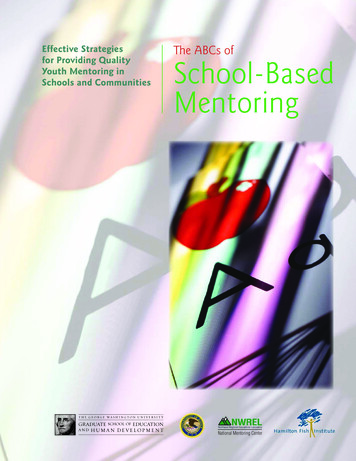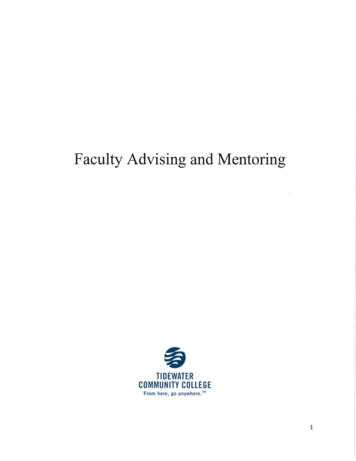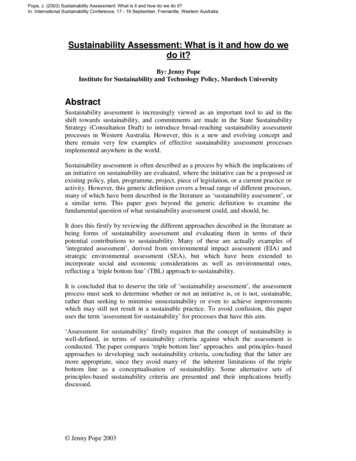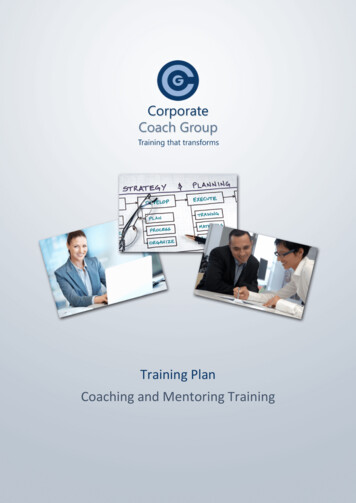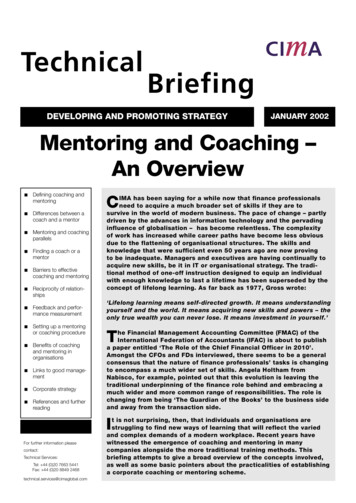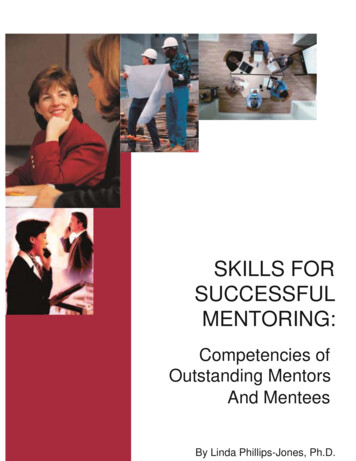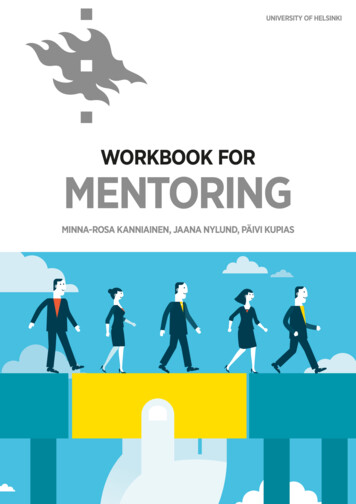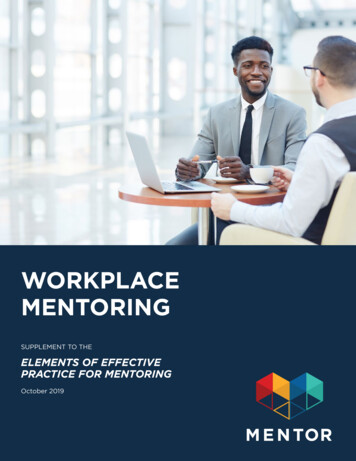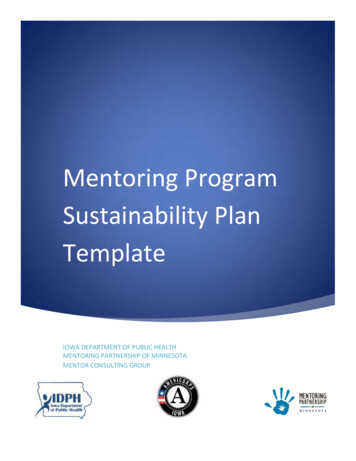
Transcription
Mentoring ProgramSustainability PlanTemplateIOWA DEPARTMENT OF PUBLIC HEALTHMENTORING PARTNERSHIP OF MINNESOTAMENTOR CONSULTING GROUP
Table of Contents Instructions – 2Introduction – 3Mission/Vision/Values – 4Internal & External Assessment – SWOT Analysis – 6Logic Model – 8Program Evaluation – 10Implementation of Quality Program Activities – 12Community Partnerships - 16Marketing – 19Key Messages – 19Branding – 20Marketing Planning – 21Financial Infrastructure – 23Funding Mix – 27Develop Goals and Objectives for Sustainability – 30Prospect Worksheet – 33Sustainability Questions – 341
InstructionsThe following workbook will lay the foundation for developing a sustainability plan. The activities willassess your current situation, internally and externally, so you have a firm understanding of yourorganizational identity, your strengths, and how to communicate that to funders and individual donors.Every organization is unique, so approach these tasks with some flexibility.The template is divided into topics. Each topic includes planning exercises as well as questions. Pleasecomplete each planning exercise and compile the question answers and exercises into a sustainabilitypacket. If your organization already has the required item or something similar, please update and usethe pre-existing document. The complete list of questions is at the end of the template (pg. 34).As you work on this review, gather together documents that can provide the information you need: Your common grant application Agency and program budgets detailing all sources of funding Your most recent annual report Board of Directors roster, their skills and connections in the community Policy and procedure manuals Data on program outcomes Your organization’s strategic planThis template was created by the Mentoring Partnership of Minnesota. Funding for this plan wasprovided by the Iowa Department of Public Health, Division of Behavioral Health.2
IntroductionSustainability, capacity building, resource development, fundraising—these are terms that often areused interchangeably to describe the work that nonprofit organizations do to survive and thrive.Sustainability in the context of a mentoring program refers to the overall stability of the organization:its ability to weather temporary challenges, provide quality services in the present, and maintain a solidfoundation for its future. Sustainability is impacted by all the key activities and functions of anorganization and all major activities are, in turn, affected by the ability of an organization to sustain itself(The National Mentoring Center).The process of sustainability planning starts with reviewing your resources and environment. Takingstock of the internal and external resources your organization has at its disposal.Capacity-building is the process by which an organization strengthens its foundations in order toincrease its ability to carry out its mission. Agencies with strong organizational capacity are more likelyto be sustainable.Sustainability requires a plan for services and practices that result in positive outcomes for children andyouth as well as a plan for sharing the positive impact you create with your stakeholders in thecommunity. Sustaining a mentoring program requires understanding the systems in which it operates(e.g., schools, foster care, the juvenile justice system), as well as the relevant policies and infrastructuresthat foster internal quality and stabilityGetting the ball rolling is often the hardest part of sustainability planning because it requires reflection,time, conversation, and energy. It is important to note that this process isn’t necessarily linear and thatthe plan you develop is, and should be, a living document that requires frequent updates andadjustments to remain effective.3
Mission/Vision/ValuesUnless your organization can clearly articulate its purpose, you may struggle to stay on point andprocure resources that are a good fit for your values. Mission and vision statements establish the longterm direction and goals that guide a nonprofit's operations. They provide a foundation for a nonprofit'sprograms, services, communications, organization and culture and create a shared vision for your staff,board members, and other stakeholders.Developing a Mission Statement (Adapted from the Field Guide to Nonprofit Strategic Planning andFacilitation) The mission statement describes the overall purpose of the organization. It is one-sentence thatdescribes why an organization exists.When wording the mission statement, consider the organization's products, services, markets,values, concern for public image, and priorities of activities.When refining the mission, a useful exercise is to add or delete a word from the mission torealize the change in scope of the mission statement and assess how concise is its wording.Does the mission statement include sufficient description that the statement clearly separatesthe mission of the organization from other organizations?Developing a Vision Statement (Adapted from the Field Guide to Nonprofit Strategic Planning andFacilitation) The vision statement includes vivid description of the organization as it effectively carries out itsoperations. It is a one‐sentence statement describing the clear and inspirational long-termchange resulting from your work. It can be a motivational tool.Developing a vision statement can be quick culture-specific, i.e., participants may use methodsranging from highly analytical and rational to highly creative and divergent, e.g., focuseddiscussions, divergent experiences around daydreams, sharing stories, etc.Questions to consider include: What are the major issues and problems? Why should thoseissues be addressed? What are the strengths and assets of our organization? Of those beingserved? What is your dream end-state? What does success look like?Developing a Values Statement (Adapted from the Field Guide to Nonprofit Strategic Planning andFacilitation) Values represent the core priorities in the organization’s culture, including what drivesmembers’ priorities and how they truly act in the organization, etc. Values are increasinglyimportant in strategic planning.Establish four to six core values from which the organization would like to operate. Considervalues of clients, shareholders, employees and the community.4
Our mission statement is:Our vision statement is:Our values are:5
Internal & External Assessment – SWOT AnalysisConsider whether there has been changes in your environment – either within your organization or anexternal factor such as an economic downturn or boom. It is likely that changes in the environment,both internal and external, will have an impact on your own work as well as potential funders. . Fill outthe SWOT Analysis worksheet (example on page 7) with the categories below:Strengths and WeaknessesWhat you write under these two sections will help you to look internally at your organization to figureout what it is you’re capable of doing and where there’s room for improvement. Your strengths caninclude things that make your initiative unique, your experience and knowledge, and the quality andreputation of your organization.When it comes to the weaknesses section of your SWOT, you should incorporate areas that need themost work. This could include a gap in skills, staffing issues, or motivational problems throughout yourorganization. From determining your weaknesses you’ll be able to fix any issues within your nonprofit,and ensure that your staff is motivated and involved.Opportunities and ThreatsMany organizations are great at looking within, but find it more difficult to examine external factors. Theopportunities and threats sections force you to focus on the conditions of the real world and how theyaffect your initiative. Opportunities can include partnerships you can make in the community, ways toreduce costs, and ideas for diversifying the organization. The threats section should include any possiblechanges in the community that could negatively impact your initiative, any strong competitors, andthings such as seasonality.Sustainability Questions:1. What is the funding climate in which your program takes place?2. What strengths stand out as being most useful for ensuring sustainability in your program?3. What challenges did you find that may inhibit the effort?4. What are available resources and needed resources for continued success?6
7
Logic ModelA logic model is a planning tool to clarify and graphically display what your organization plans toaccomplish and impact. What do we do and how do we go about it? It is a tool used by funders,managers, and evaluators of programs for planning, implementation, and evaluation. Fill out the LogicModel template on page 9 with the categories below:1.2.3.4.INPUTS: resources, contributions, investments that go into the programACTIVITIES: what the program does with the inputs to fulfill its missionOUTPUTS: services, events and products that reach people who participate or who are targetedOUTCOMES: results or changes for individuals, groups, communities, organizations,communities, or systems5. IMPACT: impact refers to a broader effect than outcomes – perhaps the effect participation hadon ability to make an informed choice, empowerment or wider life experiences. Impact is also alonger term effect than an outcome.Sustainability Questions:5. Is there any research showing that your activities lead to your targeted outputs and outcomes?6. What might get in the way of your activities leading to your outcomes? How can you preventthis?7. How will your organization continue to conduct sustained program planning?8. How will logic models be used in future efforts?8
9
Program EvaluationMentoring program evaluation serves many functions, including providing timely information to aid inmanaging day-to-day program aspects and measuring the program’s impact on mentees. Evaluationdata can also be used to demonstrate to stakeholders and the community at large that the program iseffective and worth sustaining. Complete a basic Evaluation Plan using the template on page 11 orattach your organization’s Evaluation Plan.Sustainability Questions:9. What are your most compelling outcomes to date? Use your most recent evaluation or programdata, as well as anecdotal success stories.10. How will your organization continue to evaluate outcomes?11. What if any changes would you make to your evaluation tools or processes?12. What data or information systems help you support this evaluation?10
11
Implementation of Quality Program ActivitiesMentoring programs are more likely to reach their desired outcomes when they employ evidence-basedbest practices in their program design and mentoring operations. Quality analysis looks at yourprogram’s adherence to these best practices, based on The Elements of Effective Practice for Mentoring.Complete the following National Quality Mentoring System Self-Assessment Tool (page 13) which willlook at your internal strengths, challenges, and opportunities. If areas of significant concern emerge,such as a lack of commitment to the project by top-level administration, you will likely need to work onthese before launching a fundraising effort. Similarly, areas of strength that emerge, such as acommitted working Board of Directors, can help drive implementation of your plan.Sustainability Questions:13. Which program activities are being conducted with a high level of intentionality with regards toquality and best practices?14. What activities are not yet in practice or net yet being conducted with intentionality?15. What are the training and technical assistance needs of staff?12
NATIONAL QUALITY MENTORING SYSTEM SELF-ASSESSMENT TOOLPROGRAM DESIGN AND PLANNING 1. Do you detail your overall program mission, goals and outcomes for mentees, mentors andother key stakeholders? 2. Do you have a Financial Plan?PROGRAM MANAGEMENT 3. Do you have a program Policies and Procedures Manual that includes a section on riskmanagement?4. Please check which of the following practices you are currently implementing: Advisory GroupA system for managing program information, such as mentor and mentee personal dataA system to monitor the overall programProfessional development for staffAn up-to-date resource development planA practice of advocating for mentoringA public relations/communications effortPROGRAM OPERATIONS5. STANDARD 1: RECRUITMENT 6. Do you engage in mentor recruitment strategies that realistically portray the benefits,practices and challenges of mentoring in the program? 7. Do you recruit youth whose needs best match the services offered by the program and helpsthem understand what mentoring is and what they can expect from a mentoring relationship?8. STANDARD 2: SCREENING 9. Do your mentors complete a written application? 10. Do your mentors agree to a one year (calendar or school) minimum commitment for thementoring relationship? 11. Do your mentors agree to participate in in-person meetings with the mentee that averageonce a week and one hour per meeting? (May be combination of in person and online; may beless than once a week but more than one hour per meeting.) 12. Do you conduct a pre-match in-person interview with potential mentors?13
13. Do you conduct a reference check on potential mentors? 14. Do you conduct a comprehensive criminal background check on adult mentors, includingsearching a national criminal database and sex offender registry? 15. Do parents/caregivers complete an application and provide informed consent for their childto participate? 16. Do parents/caregivers and mentees agree to a one year (calendar or school) minimumcommitment for the mentoring relationship? 17. Do parents/caregivers and mentees agree that mentees will participate in required meetingsthat average once a week and one hour per meeting? (May be combination of in person andonline; may be less than once a week but more than one hour per meeting.)18. STANDARD 3: TRAINING 19. Do you provide a minimum of two hours of pre-match, in-person training for mentors? 20. Do you provide a pre-match mentor training? If yes, does the mentor training include thefollowing topics, at a minimum: (Check all that apply) Program rules Mentor goals and expectations for mentor/mentee relationship Mentor obligations and appropriate roles Relationship development and maintenance Ethical issues that may arise related to the mentoring relationship Effective closure of the mentoring relationship Sources of assistance available to support mentors Other 21. Do you have an Orientation/Training handbook for Mentors?22. STANDARD 4: MATCHING 23. Do you consider your program goals, as well as the characteristics of the mentor and menteewhen making matches? 24. Do you arrange and document an initial meeting between the mentor and mentee?25. STANDARD 5: MONITORING AND SUPPORT 26. Do you contact the mentor and mentee at a minimum frequency of twice per month for thefirst month of the match and monthly thereafter?14
27. Do you document information about each mentor-mentee contact, including, at minimum,date, length and nature of contact? 28. Do you provide mentors with access to at least two types of resources to help mentorsnegotiate challenges in the mentoring relationship as they arise? 29. Do you follow evidence-based protocols to elicit more in-depth assessment from the mentorand mentee about the relationship and uses scientifically-tested relationship assessment tools? 30. Do you provide one or more opportunities per year for post-match mentor training?31. STANDARD 6: CLOSURE 32. Do you have a procedure to manage anticipated closures, including a system for a mentor ormentee rematch? 33. Do you have a procedure to manage unanticipated match closures, including a system for amentor or mentee rematch? 34. Do you conduct and document an exit interview with each mentor and mentee?PROGRAM EVALUATION 35. Do you have a plan to measure program process? If yes, does it include: (Check all thatapply) Indicators of program implementation viability and volunteer fidelity, such as traininghours, meeting frequency and relationship durationA system for collecting and managing specified data36. Does your plan to measure expected outcomes Specify expected outcomesSelect appropriate instruments to measure outcomesSelect and implement an evaluation design37. Do you have a process to reflect on and disseminate evaluation findings? If yes, check allthat apply below: Refine the program design and operations based on the findings – if warrantedDevelop and deliver reports to program constituents, funders and media yearly,optimally, each quarter15
Community PartnershipsYour mentoring program probably has both formal and informal partnerships with people andorganizations in the community. These include your primary stakeholders: your families, volunteers,staff, and leadership. Start to map your organization’s partnership by completing a Relationship Map (pg17). Formal partnerships could be between schools or other educational agencies and one or morecommunity- or faith-based organizations. These may be financial or nonfinancial agreements to carryout certain parts of the mentoring service, and obligations under the agreement are spelled out in amemorandum of understanding (MOU) or financial contract. Your agency may also have informalpartners—organizations that support your work and see its value to their own mission. For example, atobacco prevention program in the schools may refer young people or volunteers to your mentoringprogram and will seek opportunities to present their information to your mentors and mentees throughinvitations to events or coming to your mentoring training sessions. Your current business supportersshould also be included in your assessment of partnerships. Their contributions may range from allowingyou to place posters on their bulletin boards to making regular financial contributions to your program.Sustainability Questions:16. Which community partnerships would you like to enhance? To what benefit?17. How will you engage these new relationships?18. Which community partnerships are no longer serving your organization?19. How does your organization maintain positive relationship with community partners?16
Relationship MappingThis activity begins to help your organization understand all the people and organizations that alreadycare about your work and support you in a variety of ways. Webs are visual maps that show howdifferent categories of information relate to each other. They provide structure for ideas and facts andprovide a framework for organizing and prioritizing information. Links from the center 5-will connectyour key stakeholders and core constituencies as well as track details of their connections to you.1. Draw a circle, in the middle write the name of your program2. Write down all the names of organizations and groups of individuals that have a connection toyour program. Don’t limit yourself!3. Spend a few minutes listing all the resources that each group has along the line connecting themto you (knowledge, experience, access, space, ideas, MONEY)4. Spend some time discussing/jotting down notes on the self interests of the people and groups.Why are they connected to your program? What’s in it for them?17
Your Org18
MarketingYour program exists to provide quality mentoring services that support the mission of your agency.However Image becomes important as soon as you need to acquire something, such as participants(youth, school staff, mentors, etc.) or funding to run your program. It is important to actively choose andmanage your program’s image among your various target audiences for effective sustainability. Youmust present your program in a way that will compel others to buy into it.It is critical to communicate about your mentoring program to prospective mentors and mentees, schooladministrators and staff, parents, youth-serving agencies, community leaders, and other stakeholders.Communicating the success of your program enhances community awareness of the positive impact ofmentoring and can also help to engage program partners and current and potential funders, which canlead to new collaborations, funding, and further enhancements to the program.Communications and Marketing involves identifying the key audiences to be reached (pg. 20), creatingsimple communications messages that appeal to those audiences (pg. 20), and identifying andemploying the most effective communications channels (e.g., Internet, e-mail, social media, publicmeetings, print materials, radio) to reach and engage your key program’s audiences in a comprehensiveplan (pg. 22).Sustainability Questions:20. What marketing strategies have proved most successful at bringing in resources and enhancingyour sustainability?21. How does your organization measure the impact of its marketing efforts?19
Key MessagesAccording to Access Philanthropy, Key Messages are a set of statements that are the most importantthings about us to make the biggest impact to a specific audience. (Not necessarily the most importantto us!). There are a lot of ways you can communicate about the same thing. What do they want to hearand what do you want to say to get the attention or support you want and need? Choose three keyaudiences that your mentoring program communicates with in hopes of support, resources, orpartnership. What is important to them?Examples of stakeholders include: Students, parents, and families, Educators – principals, schoolsuperintendents, teachers, Government and political leaders, State or federal legislators,Representatives from cultural and ethnic groups, Leaders in business, Local funders, Representativesfrom faith-based organizations, Media representatives, and more The test of a good key message – Is it:– True? – Unique? – Short? – Human? – Memorable? – Persuasive?Audience 1:Key Message:Audience 2:Key Message:Audience 3:Key Message:20
Marketing PlanningA marketing plan will help ensure the success of your mentoring program by engaging stakeholders inand shaping the way the effort is perceived by everyone invested in or affected by this issue. Yourcommunication plan can help you raise public awareness of your needs, challenges, and successes, andobtain needed funding, support, and volunteers. Please fill out the Marketing Plan on the following pageor attach your organization’s marketing or communications plan.Your marketing action plan should provide clear, concise direction for your marketing efforts and helpyou to measure the success of your efforts. The action plan should do all of the following: State the broad marketing object (e.g., awareness, fundraising, volunteer recruitment) and tactics(specific activities selected to implement the strategies) you plan to use such as tabling, handing outbrochures, sending an email blast, or writing a press release. Establish target dates for each activity; Assign responsibilities and define individuals’ involvementThe methods and techniques chosen to include in the action plan will depend on your community,programming, technology, and skillsets.21
Marketing dFrequencyResponsibleParty22
Financial InfrastructureTo ensure adequate funding for a program’s long-term sustainability, practitioners have to engage inmany activities. For optimal program viability, organizations should be organizationally healthy with astrong Board of Directors, solid financial practices, and structured development policies. The followingtwo checklists, from The Handbook of Youth Mentoring, 2nd Edition, provide an overview of some of therequirements to have a strong infrastructure for fundraising including staff, volunteer, and Boardsupport. They are followed by a third checklist from the Nonprofit Finance Fund to assess your revenue,expenses, profitability, health, liquidity, and financial planning. Please complete the checklist andanswer questions when prompted, when applicable.23
Checklist for Practitioners: Planning Phase of Funding a Mentoring Program(Handbook of Youth Mentoring, Second Edition) Does the agency currently have 501(c)(3) tax-exempt status? If not, who is an expert on yourboard or in the community that you could rely on to assist in completing the paperwork toachieve this status?How much of the revenue coming in to the agency has conditions attached to how it is spent?How much of the revenue is restricted? Do you receive funding from many sources rather thanjust one such as a federal grant? How much money can you rely on as secured funding year afteryear?Does the board of directors represent a broad cross-section of community members withexpertise and contacts? Has each members indicated how he or she can assist in the fundraisingprocess, when, and with whom?Do you have any members of the board who do not have term limits? How will you now bringon new members and retire those who are not doing the job required of an effective boardmember?If 100% of the members on your board do not give yearly to the program, how will you changethis? If you do not like to ask your board for money, do you have a board chair who can take onthis important assignment after making his or her own donation?Are you able to identify a team of volunteers and board members who have the time, interest,and expertise to assist the program manager with the agency’s fundraising efforts?24
Checklist for Practitioners: Funding Sources for Mentoring Programs(Handbook of Youth Mentoring, Second Edition) What challenges will you encounter in identifying board members and other volunteers to helpthe manager to seek multiple sources of funding?Who will monitor the federal register for Requests for Proposals for federal grants?What kind of tracking system will you need to develop to collect data and to monitor contactswith revenue sources and results of your efforts?Do you track alumni of your mentoring program – mentors and mentees – and ask them to helpfund your program?Do you have a champion among local, state, or federal legislators?Do you have a list of companies with a strong history of support for your program that couldnow provide you with program funding?Is your agency a member of the Chamber of Commerce? Will you encounter any resistance tojoining from your local board or others?Do you have an attorney and an insurance agent on your board who can provide professionaladvice in areas such as insurance for special evets and planned giving?What policies will you put in place around fundraising?How will you rank in terms of your timeliness for saying “thank you” to donors?What will you need to do to prepare for rejection?25
26
Your Funding Mix(Center for Nonprofit Stewardship)For optimal sustainability, multiple funding sources should be in play. This can include governmentfunding, family foundations, corporate giving, individual donations, earned income, in-kind donations,and more. Use the following worksheet to determine your current funding mix and plan for the future.Use your organization's current budget or last year's end-of-year Profit & Loss Statement to determinemajor revenue sources. Enter the amounts into the corresponding fields below. You may need tocombine some items to make them fit into the categories. From this information, draw the estimatedportions on the blank pie chart below.Possible Major Revenue SourcesFundraising(donations, events, sponsorships, etc.) %Earned Income(program revenue, contracted services, sales, etc.) %Membership Dues(if a membership organization) %Grants %Investments %Other: %Total: 27
Revenue Pie Chart(*to determine the %, divide the line item amount by the total)1. Take a moment to review the findings from Part 1 (completed by your Treasurer) and consider if youare comfortable with your organization's current funding mix. Then, complete the sentences below.What looks good here is.What makes meuncomfortable is.I need more informationabout 28
Sustainability Questions:22. How stable is the funding in each of your revenue sources?23. What could affect your future funding mix?24. Will this same funding mix work for your organization in 1, 3, 5 years?25. What would happen if one of your major funding sources suddenly went away? What is apossible Plan B?26. If no, what needs to be put into place now to get ahead of the transition or become morestable?27. What is your organization’s ideal funding mix?29
Develop Goals and Objectives for SustainabilityBy now, if you have worked through the activities above, you should have some ideas about the specificgoals and measurable objectives that will lead you to a more stable and sustainable mentoring program.This is the exciting part, the building of a clear road map that will take you from knowing where you areto knowing where you want to go and how to get there.Identifying goals and objectives can be an exciting and dynamic process for your team, and one thatrequires careful facilitation and enough time to really examine these important ideas. Goals should bebrainstormed, discussed, and prioritized first, before you get into the more detailed work of listingspecific objectives and activities. Make sure you have a clear process that will allow initial creativity andgood discussion, followed by a means of narrowing the ideas into a few that respond best to your statedpriorities and your assessment results. Brainstorming can be effective initially, but be sure thatdiscussion and narrowing follow.To create meaningful goals and objectives, keep these definitions in mind:GOALS are broad statements that describe the change you hope to achieve. They are more abstract thanobject
Developing a Mission Statement (Adapted from the Field Guide to Nonprofit Strategic Planning and Facilitation) The mission statement describes the overall purpose of the organization. It is one-sentence that describes why an organization exists. When wording the mission statement, consider the organization's products, services, markets,
